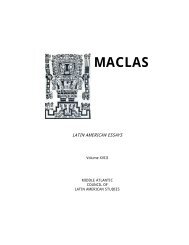latin american essays maclas
latin american essays maclas
latin american essays maclas
Create successful ePaper yourself
Turn your PDF publications into a flip-book with our unique Google optimized e-Paper software.
the indigenous population, which might conceivably have made it a major threat<br />
in the future.<br />
The context of revolutionary insurgency, repressive counterinsurgency,<br />
severely exacerbated by U.S. intervention, was profoundly threatening to Central<br />
America’s closest neighbors (Mexico, Colombia, Venezuela and Panama) whose<br />
governments formed the Contadora group in the early 1980s. Their purpose was<br />
diplomatic mediation to reduce international tensions in Central America. They<br />
took the existing governments of the region (including the Sandinistas) as given,<br />
seeking to promote diplomatic settlements of disputes between existing<br />
governments. Contadora was strongly opposed by the U.S. government, which<br />
successfully induced all countries but Nicaragua to scuttle the<br />
Contadora peace plan in 1986. 3<br />
However, this was the high point of Reagan Administration influence in<br />
Central America, as the Iran-Contra scandal (Walsh 1994) broke later in the year,<br />
exposing deliberate violations of law at high levels and effectively immobilizing<br />
the Administration’s Central American policy. Costa Rica’s newly elected<br />
president, Óscar Arias, saw an opening for a comprehensive negotiated peace.<br />
In the course of 1987, a peace plan was negotiated and agreed upon by all five<br />
Central American presidents. It was based on the Contadora proposal, but went<br />
beyond that initiative in also committing each government to negotiating a peace<br />
settlement that would end the insurgencies and incorporate the former<br />
insurgents into a constitutional, democratic regime. The Arias Peace Plan was<br />
thus the foundation for negotiated settlements and democratization in Nicaragua,<br />
El Salvador and Guatemala (Honduras had no internal insurgency, though it was<br />
the principal base for the Nicaraguan Contras, and Costa Rica had no insurgency,<br />
though it too had been a Contra base). 4<br />
Nicaragua, as the only revolutionary regime in the region, was<br />
indispensable to the success of the plan, because its neighbors would see no<br />
incentive to negotiate their own peace settlements until they could see that the<br />
subversive threat from Nicaragua was ending. At the same time, the peace plan<br />
was most welcome to the Sandinista government because it promised to<br />
undercut U.S. support for the Contras and to encourage opposition elements to<br />
participate in democratic politics rather than insurgency and subversion.<br />
Thus, the main focus of attention was on the peace negotiations in<br />
Nicaragua from late 1987 to late 1990. With the Reagan and George H. W. Bush<br />
Administrations doing whatever they could to undermine the negotiations, to<br />
discourage opposition parties from participating, and to keep the Contras intact<br />
as a fighting force, the vast majority of Nicaragua parties and factions, including<br />
most of the Contras, nevertheless did agree to demobilize and participate in the<br />
November 1990 general elections, conducted under the 1987 Constitution and<br />
with large numbers of international observers (Walker 1991).<br />
The Bush Administration (1989-1993) did its best to encourage opposition<br />
boycotts, and openly predicted widespread, officially coordinated fraud. Much of<br />
17




